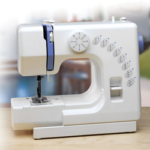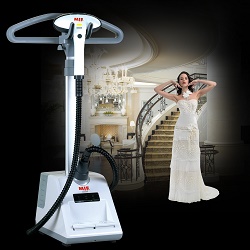Rules of work on the manual sewing machine
The basic principles of the sewing machine, the user must learn before beginning to master the basics of tailor skill. Depending on the type and features of the device, some subtleties of use may differ. A manual sewing machine is a unit that has been around for many years, but not everyone knows how to use it properly.
Preparation of the sewing machine for work consists of several stages:
- studying the instructions for the device;
- needle installation;
- threading;
- selection of the desired sewing mode.

Content
User's manual
Even in the process of choosing the right device, you should ask about the availability of instructions for the model of sewing machine you liked in Russian. The presence of such a document in the kit is especially important for thosewho has never dealt with such devices. This also applies to the purchase of used cars through the bulletin board. In extreme cases, before buying it is worth taking care of finding instructions on the Internet.
Of course, if you buy a model of an old-style manual sewing machine, for example, “Podolsk or Singer”, Is unlikely to get to her original terms of use. Sometimes this is not required, since such devices are easy to configure and use. It is easy to refill and maintain. Such devices are reliable, so they are still appreciated. Another advantage of old manual sewing machines is possibility of sewing thick fabrics - this is beyond the power of most modern household models.
Needle installation
Only having studied the safety rules when working on a sewing machine, you can proceed directly to its use. The first thing to do is to install the needle correctly. This applies to all models, be it with a manual or foot operated.
Needle thickness is selected depending on the material that will be used when sewing. Together with a sewing machine, it is best to purchase a set of needles - this will allow you to work with fabrics of different types and thicknesses.
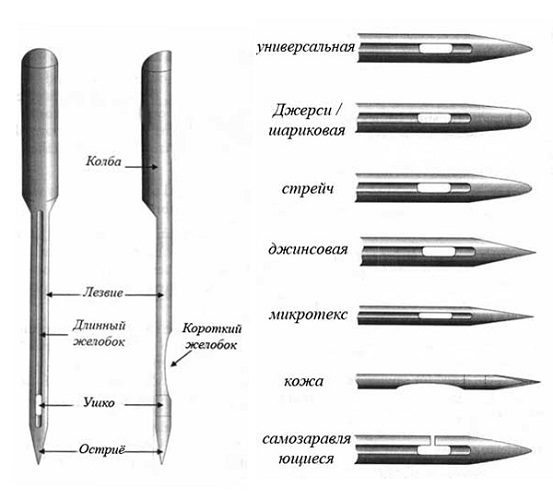
Sometimes these sets provide comments on the numbers of needles, to which fabrics they fit.
To install the needle, you must perform the following steps.
- To put needle holder to the topmost position by scrolling the flywheel.
- The needle for the sewing machine has a special structure, after studying which, you can easily install it correctly. The flat side of the bulb inserts the needle out, and the long groove inward (to the base of the sleeve).
- The needle is screwed all the way into the holder provided for it and secured with a screw.
Proper installation of the needle is very important. Otherwise, no loops will be created during operation, which will lead to passes.
How to fill a sewing machine
Filling modern devices is simple: as a rule, in the instructions all actions are shown in schematic drawings. The case of modern devices has digital symbols or arrows that help in threading. But if the document and the drawings are missing, you will have to cope on your own.
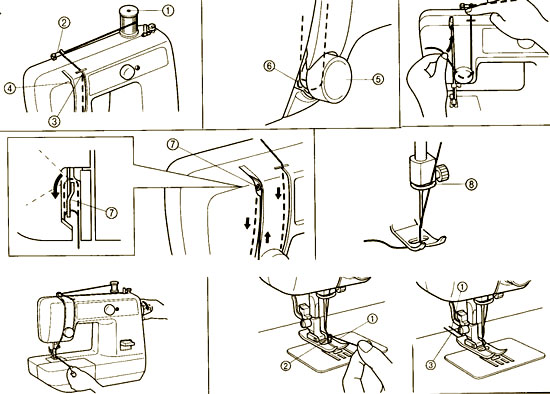
Instructions for threading the upper thread
Always start at the top. Capturing the end of the thread, it is passed through a small window on the rear panel of the device, taken away to the tension regulator, inserted into the corresponding loops and outputted to the needle.
If the dressing is incorrect, there is a risk that the thread may be rubbed during the sewing process or the unit may not function properly.
Threading the lower thread also carried out in accordance with certain rules. Regardless of the type and model, the shuttle is charged (setting the bobbin) in such a way that the thread goes out in a clockwise direction. When refueling, pay special attention to the thickness of the thread (its number) - it should be the same. The rules for working on a sewing machine require winding the thread on a bobbin from the same spool that will be set for the upper thread.
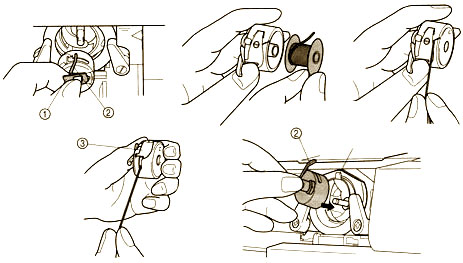
Instructions for threading the lower thread
How to fill a sewing machine
To pull the lower thread, you must:
- take the end of the upper thread (not pulling it), which is already inserted into the needle;
- lower the needle into the needle plate using the flywheel;
- the needle will capture the shuttle thread, it will only need to pull out.
Mode selection
Before work, you should study the location of the switch modes, thread tension, reverse. Modern models provide on the case of the device a graphic image of the types of stitches (straight stitch, zigzag, overcasting, etc.), on old machines the choice of stitches is not so great.For reverse (to secure the thread at the end of work) all models provide a small lever.
After all the preparatory activities, the material is enclosed under the foot, which is then lowered onto it, and you can proceed directly to sewing.
Sewing mini-machines
The modern market of sewing devices is quite diverse. Today, manufacturers produce miniature hand-sewing machines that fit in their hand. Their main advantages are:
- compact size;
- lack of complicated threading mechanisms;
- ease of use;
- You can adjust the stitch length.
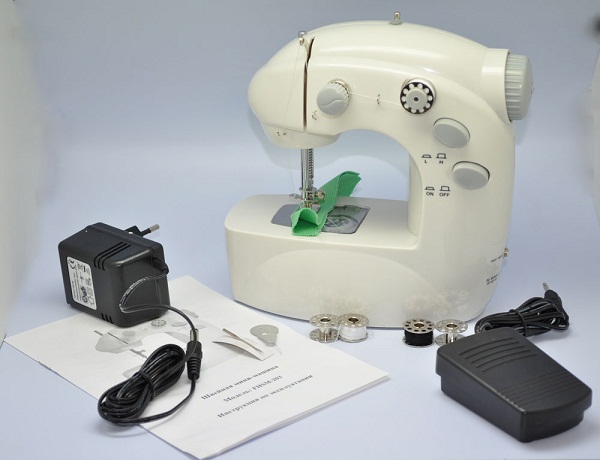
The features and rules for how to use a hand-held compact sewing machine are very simple. Simply insert one thread, select the stitch length, and you can immediately start sewing. They can be easily take you on the road. They are suitable for performing urgent repair of clothes or adjusting the length of curtains, without removing them from the curtain.
General Rules for Using Hand Sewing Machines
Hand-operated sewing machines must be carried out in strict compliance with safety regulations.
- It is permissible to turn the flywheel in one direction only - to myself. Rotation in the opposite direction will cause the shuttle thread to tangle.
- If the machine is not operated, the clamping foot must be in the raised position.
- You can not work on a typewriter without cloth. This will blunt the lower teeth of the foot.
- During operation, the material is not allowed to stretch; it is only necessary to adjust its direction. All the work on the movement of the machine produces itself.
- While working bobbin lid on the case must be closed.
- During operation, do not hold your fingers close to the needle or try to straighten the thread of a working device.
- You can not sew on pins, fastening the thread - it will break the needle.
To master the work on the sewing machine is not difficult. The main thing is to act according to the instructions and strictly observe safety.

/rating_on.png)
/rating_off.png)






